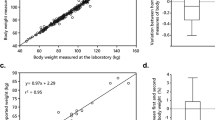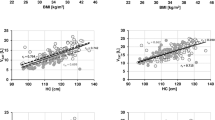Abstract
AIMS: We studied the relationship of subcutaneous adipose tissue layers (SAT-layers) measured at 15 specified body sites with leptin before and after a weight loss program for three weeks.
SUBJECTS AND METHODS: In 70 obese girls, SAT-layers were measured by means of the optical device, lipometer. Fat mass (FM) was estimated by means of bioelectrical impedance.
RESULTS: At the beginning of the study, all estimates of adiposity, insulin, and SAT-layers from the upper body (from 1–neck to 6–lateral chest) were correlated to leptin at a P-value of<0.0001. Percentage FM together with SAT-layer 4–upper back and insulin explained 75% of the variation in leptin (P<0.0001). After three weeks, estimates of adiposity and leptin were reduced (all P<0.0001). Most SAT-layers were reduced, but SAT-layers 8–lower abdomen and 9–lower back were significantly increased. Changes in leptin were best explained by initial leptin, but percentage change (Δ) in insulin, Δ SAT-layer 1–neck, and Δ SAT-layer 3–biceps contributed to the Δ leptin (adj. r2=0.47, P<0.0001). In the weight-reduced state, circulating leptin was best explained by three SAT-layers and insulin (adj. r2=0.67, P<0.0001).
DISCUSSION: The results suggest that Δ changes in leptin are attributable to changes in the endocrine state and subcutaneous fat, and SAT-layers may serve as a stable correlate of leptin in the weight-reduced state.
This is a preview of subscription content, access via your institution
Access options
Subscribe to this journal
Receive 12 print issues and online access
$259.00 per year
only $21.58 per issue
Buy this article
- Purchase on Springer Link
- Instant access to full article PDF
Prices may be subject to local taxes which are calculated during checkout
Similar content being viewed by others
Author information
Authors and Affiliations
Corresponding author
Rights and permissions
About this article
Cite this article
Sudi, K., Gallistl, S., Tröbinger, M. et al. Subcutaneous adipose tissue layers as a stable correlate of leptin in response to short term energy restriction in obese girls. Int J Obes 25 (Suppl 1), S43–S45 (2001). https://doi.org/10.1038/sj.ijo.0801697
Issue Date:
DOI: https://doi.org/10.1038/sj.ijo.0801697



